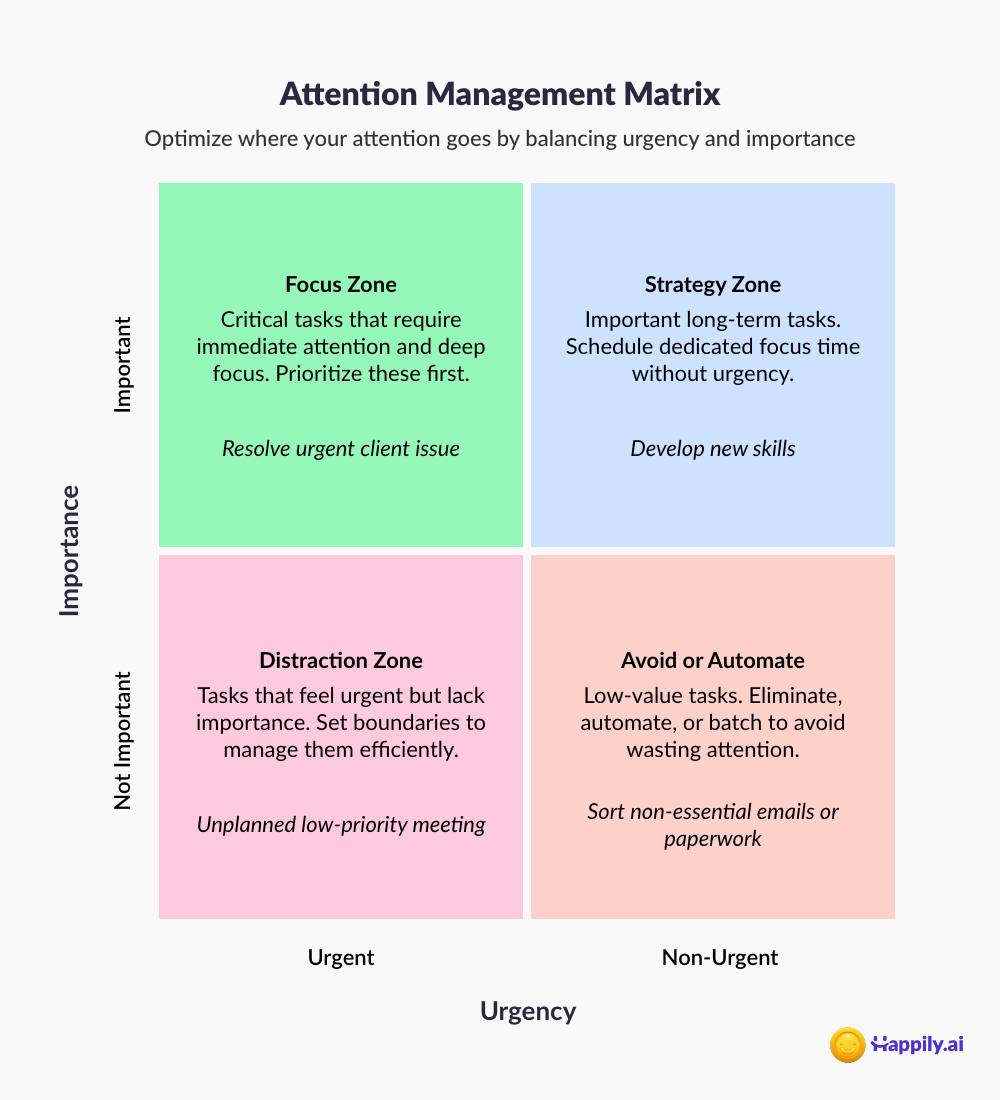Many employees feel constantly busy yet unproductive. Workloads seem to pile up, and unresolved anxiety is ever-present, leaving us with an unsettling feeling of being overwhelmed. But the real issue isn’t time management—it’s attention management. As we spend more of our workday reacting to distractions and shifting our focus from one task to the next, we lose the ability to direct our attention toward the work that matters most.
The Attention Crisis in the Workplace
Our recent data on workplace stress reveals that employees are struggling to manage their attention more than their time. Two key themes dominate:
- Workloads that feel unmanageable, leaving employees exhausted but unaccomplished.
- Unresolved anxiety, stemming from constant distractions and the inability to focus on high-impact tasks.
Employees often find themselves at the end of the day struggling to identify their most meaningful accomplishments, despite having been busy from start to finish. The truth is, time isn't the limiting factor—attention is.
The Cost of Distractions: 23 Minutes to Regain Focus
Research from UC Irvine sheds light on the real cost of distractions. After each interruption, it can take more than 23 minutes to regain deep focus. Interestingly, tasks completed after interruptions are often finished faster, but at a significant cost: workers report increased stress, frustration, and time pressure. This rushed pace is a coping mechanism to compensate for lost time, but it leads to a steep mental toll.
In an environment filled with constant distractions, like emails and notifications, workers aren’t just losing time—they’re sacrificing their cognitive resources, leading to burnout and reduced productivity.
The Problem with Emails and Notifications
The average employee spends nearly 28% of their workday responding to emails. These frequent shifts in focus pull attention toward someone else’s priorities, leaving little room for the employee’s own critical work. When combined with the constant barrage of notifications from messaging platforms, the issue compounds.
Notifications trigger overt attention shifts—eye movements toward the stimulus. Overt attention shifts are more mentally taxing than covert shifts (which don’t require eye movements) due to the complex planning involved in saccades—the rapid eye movements that direct visual focus. Each time you glance at a notification, your brain uses extra cognitive resources, making it harder to maintain focus on the task at hand.
How to Regain Focus: Practical Strategies for Attention Management
While distractions are inevitable in the modern workplace, managing your attention more effectively can help you reclaim your focus and productivity. Here are two simple but powerful strategies to get started:
1. Turn Your Phone Upside Down
One of the easiest ways to minimize distractions is to turn your phone upside down during focus-heavy tasks. By eliminating the visual cue of a lit-up screen, you prevent overt attention shifts. This small change can help conserve cognitive energy and keep you focused on the task at hand.
2. Signal Urgency for the Benefit of Others
Leaders and team members can often underestimate how much attention they pull away when sharing information. To help reduce unnecessary distractions, use clear markers in your communication. For example:
- Use #FYI for non-urgent updates that don’t require immediate attention.
- Use #urgent to signal tasks that need immediate action.
This simple step helps clarify priorities and reduces the mental load on others, allowing them to better manage their own attention.
The Attention Management Matrix

To further enhance your ability to manage attention effectively, you can use the Attention Management Matrix, which categorizes tasks based on their urgency and importance. This matrix helps you focus on what matters and minimize distractions.
Quadrant 1: Focus Zone
- High Importance, High Urgency
- These tasks are critical and time-sensitive. They require immediate, deep focus and should be prioritized first.
Quadrant 2: Strategy Zone
- High Importance, Low Urgency
- These tasks contribute significantly to long-term goals but don’t require immediate action. Schedule time for these tasks when you have periods of uninterrupted focus.
Quadrant 3: Distraction Zone
- Low Importance, High Urgency
- These tasks often create distractions but aren’t important in the big picture. Whenever possible, delegate or minimize the time spent on them.
Quadrant 4: Avoid or Automate
- Low Importance, Low Urgency
- These tasks add little to no value. Eliminate or automate them to free up attention for higher-priority work.
Why Attention Management Matters More Than Time Management
The old model of time management focused on optimizing every minute of the day. But in a world filled with constant distractions and multiple demands on our attention, that approach is no longer enough. The most significant shift we need to make isn't finding more hours in the day—it’s reclaiming the focus we've lost. When we manage our attention effectively, we work smarter, not just faster, and we accomplish more of what truly matters.
Final Thoughts: Take Back Your Focus
The modern workplace will always present distractions, but with effective attention management, you can reduce their impact. Simple strategies like turning your phone upside down and using clear markers in communication help preserve cognitive resources and allow you to focus on tasks that drive real results.
By applying the Attention Management Matrix, you can categorize tasks in a way that prioritizes what matters most, helping you and your team navigate the distractions of daily work life with greater focus and less stress. Ultimately, the key isn’t finding more hours—it’s taking control of where and how you direct your attention.









